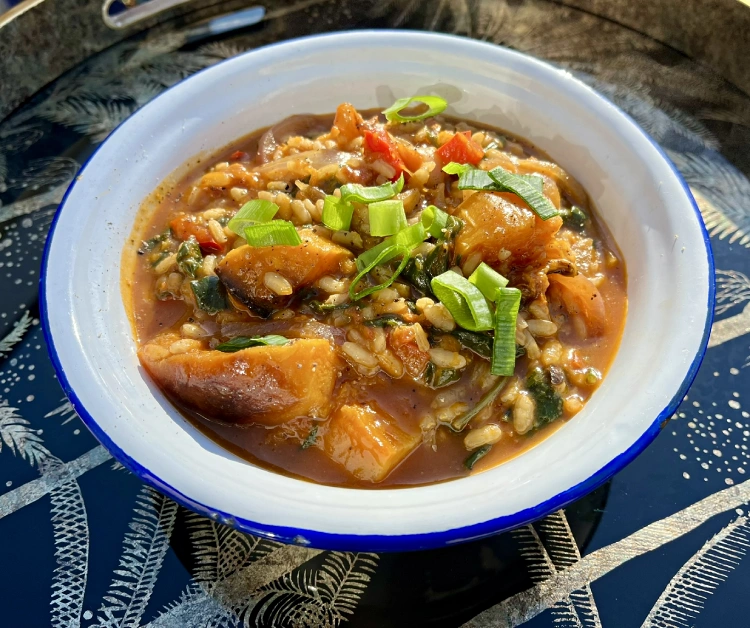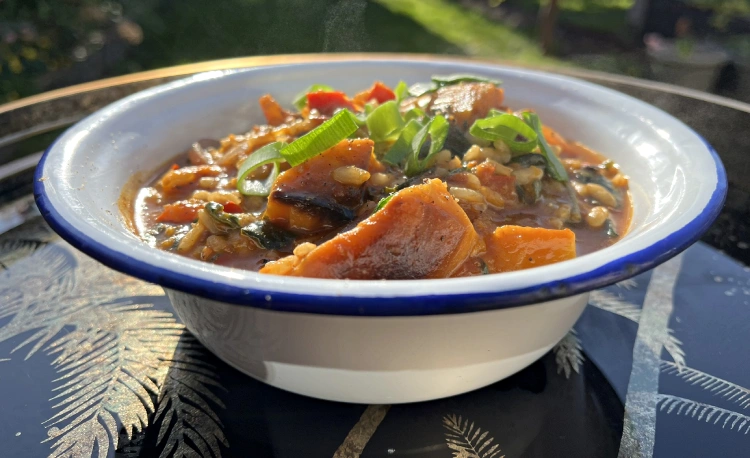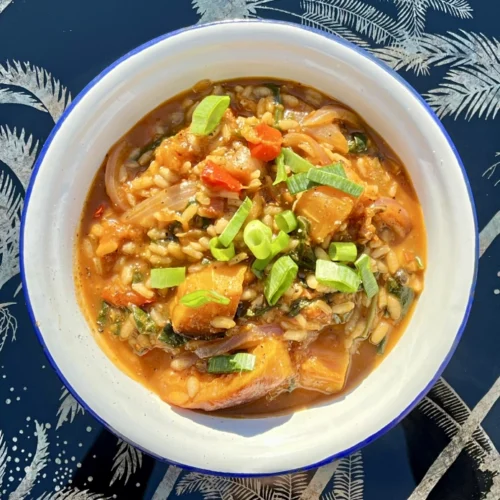Tasty Gluten-Free Butternut Squash Risotto Recipe
In the Winter, I love nothing than tucking into a big bowl of gluten-free butternut squash risotto, especially when the nights take a chilly turn.
This gluten-free butternut squash risotto recipe is not only wonderfully warming but also easy to whip up, even on a busy weeknight.
It’s packed with nutritious goodness and, best of all, absolutely delicious.
Whether you’re cooking for yourself or sharing with friends, this cosy dish always hits the spot and proves that comfort food can be both healthy and hassle-free.

Table of Contents
What you’ll love about this recipe
- It’s a proper warming hug in a bowl, perfect for when the evenings start to draw in and you need a bit of cosy comfort.
- You don’t need to be a kitchen whizz to make it; it’s surprisingly easy, even if you’re juggling a million things.
- Butternut squash adds a lovely natural sweetness and loads of vitamins, so it’s good for you, too, win-win!
- It’s gluten-free, so if you’re avoiding gluten, you can still enjoy a lush, creamy risotto without any faff.
- And honestly, it tastes so good, you might find yourself making it again and again, turning it into your go-to dinner for those chillier nights.
Fancy giving it a try tonight?

Ingredients
- 1 Butternut squash (peeled, de-seeded, cubed and roasted)
- 200g (7oz) Italian arborio risotto rice
- 1 red onion (finely chopped)
- 2 garlic cloves
- 1 large red pepper (chopped)
- 1 red chilli (finely chopped)
- 1 small glass of white wine (optional)
- 500ml (1 pint) hot gluten-free vegetable stock
- 1 400g can of tomatoes
- Black pepper
- Butter
- Parmesan cheese (for serving)
Instructions
- Preheat your oven to 400°F (Gas Mark 6). Ensure the rack is in the middle position for even cooking.
- Prepare the vegetables: Peel and deseed the butternut squash, then cut it into 1-inch cubes.
Chop the red pepper into similar-sized pieces. Peel the garlic cloves but leave them whole.
Finely chop the red chilli, removing seeds if you prefer less heat. - Place the prepared vegetables on a large baking tray. Drizzle with olive oil and season with salt and pepper. Toss to coat evenly. Roast in the preheated oven for about 1 hour, or until the vegetables are tender and lightly caramelized. Stir once halfway through cooking.
- In a large, heavy-bottomed pan, melt a knob of butter over medium heat. Add the finely chopped red onion and cook for 5-7 minutes until softened and translucent, stirring occasionally.
- Add the arborio rice to the pan with the onions. Stir to coat each grain with butter, allowing the rice to toast slightly for 1-2 minutes.
- If using, pour in a small glass of white wine. Stir constantly until the wine is fully absorbed by the rice.
- Begin adding the hot vegetable stock, one ladle at a time. Stir continuously, waiting for each ladle of stock to be almost fully absorbed before adding the next. This process should take about 18-20 minutes.
- When the rice is nearly cooked (it should be al dente – tender but with a slight bite), gently fold in the roasted vegetables, including any juices from the roasting pan.
- Add the canned tomatoes, stirring gently to combine. If desired, add extra chopped chilli for more heat.
- Cook for an additional 2-3 minutes until everything is heated through and the risotto has a creamy consistency.
- Taste and adjust seasoning with salt and freshly ground black pepper as needed.
- Serve immediately in warm bowls. Top with freshly grated Parmesan cheese and an extra grind of black pepper if desired.
Remember to stir gently after adding the roasted vegetables to avoid breaking them up too much. The goal is to have distinct pieces of butternut squash and pepper throughout the creamy risotto.

What to serve with gluten-free butternut squash risotto
To keep things lovely and balanced, here are some great things you can serve with your gluten-free butternut squash risotto:
- A crisp, fresh green salad with a tangy lemon vinaigrette to cut through the creaminess.
- Some roasted or steamed greens like broccoli, tenderstem broccoli, or green beans, for a bit of bite and extra nutrients
- Garlic bread made with a gluten-free loaf or a warm, crusty gluten-free roll if you want a bit of carb alongside.
- Grilled chicken or pan-seared salmon, if you fancy adding some protein to the meal without overpowering the risotto’s flavors.
- A light, refreshing glass of white wine like Pinot Grigio or Sauvignon Blanc to complement the sweetness of the butternut squash.
Gluten-free Butternut Squash Risotto recipe
Are you ready to try my gluten-free butternut squash risotto recipe? Then, let’s get started:

Gluten-Free Butternut Squash Risotto Recipe
Equipment
- Wooden Spoon
- Table Spoon
- Tea Spoon
- Mixing Bowl
- Roasting Dish
- Chopping Board
- Sharp Knife
- Measuring Jug
- Heavy iron based pan
- Can Opener
Ingredients
- 1 Butternut squash, peeled, de-seeded, cubed and roasted
- 200 g Italian arborio risotto rice (7oz)
- 1 Red onion finely chopped
- 2 Garlic cloves
- 1 Large red pepper chopped
- 1 Red chili finely chopped
- 1 Small glass of white wine (optional)
- 500 ml Hot gluten free vegetable stock (1 pint)
- 400 g Can of tomatoes
- Black pepper
- A knob of butter
- Parmesan cheese to serve
Instructions
- Heat oven to 400 F (Gas 6).
- Peel and cube the butternut squash. Chop red pepper, garlic, and chilli. Roast for an hour in the oven.
- Finely chop and fry the onion.
- Add the risotto rice to the onion and coat with the butter, then add the wine if using, and stir well.
- Add a ladle of the hot stock and stir. When the risotto absorbs all the liquid, you add another ladle of stock until the risotto is cooked.
- Keep stirring the risotto so the rice is evenly cooked and to stop it from burning. The risotto is cooked when the rice is tender but firm to the bite.
- Once the rice is cooked, add in the roasted vegetables, a tin of tomatoes, and more chilli if needed, and stir well.
- Serve with black pepper and parmesan cheese.
Nutrition
If you enjoy my gluten-free butternut squash recipe, then check out more of my recipes 👇
Gluten-free Butternut Squash Risotto tips
Here are some tips to help you make the most out of this recipe:
Ingredient Selection
Choose high-quality arborio rice, which is naturally gluten-free and essential for achieving the classic creamy risotto texture. Ensure all broth and stock cubes are certified gluten-free to prevent cross-contamination.
Preparation Techniques
Roast the butternut squash beforehand to intensify its natural sweetness and develop deeper flavours.
Warm your stock/broth before adding to the rice to maintain a consistent cooking temperature.
Use a heavy-bottomed pan or Dutch oven for even heat distribution.
Cooking Method
Stir constantly during the risotto-making process to release the rice’s starches and create a creamy consistency
Add liquid gradually, allowing each addition to be almost fully absorbed before adding more
Toast the rice in butter or olive oil for 1-2 minutes before adding liquid to enhance the flavour.
Flavor Enhancements
Use white wine to add depth and complexity to the dish and finish with freshly grated Parmesan cheese.
Season with fresh herbs like thyme or parsley, and add a knob of butter at the end for extra richness.
Pro Tips
Use fresh Parmesan and grate it yourself for the best flavor and serve immediately for optimal texture.
Leftovers can be transformed into arancini (risotto balls)
Frequently Asked Questions
Can I use a different type of rice for risotto?
While arborio rice is the most commonly used for risotto due to its high starch content, you can also use other short-grain varieties like Carnaroli or Vialone Nano. These alternatives will yield a similar creamy texture.
Is it necessary to use wine in the recipe?
Wine adds depth and complexity to the flavor of the risotto, but it is not essential. If you prefer to avoid alcohol, you can substitute with additional broth or use a splash of apple cider vinegar for acidity.
How do I achieve the perfect creamy texture?
The key to a creamy risotto is to add hot broth gradually and stir regularly. This process releases the starches from the rice, creating a smooth and creamy consistency. Avoid adding too much liquid at once, as this can prevent the rice from cooking evenly.
Can I make this risotto ahead of time?
Risotto is best served fresh, as it can become thick and lose its creamy texture when reheated. However, you can prepare the roasted butternut squash and cook the rice separately, then combine them just before serving.
How should I store leftovers?
If you have leftover risotto, store it in an airtight container in the refrigerator for up to three days. When reheating, add a splash of broth or water to loosen it up and restore its creamy texture.
What can I add to enhance the flavour?
You can add various ingredients to enhance your risotto, such as sautéed mushrooms, spinach, or herbs like thyme or sage. For added richness, consider stirring in some cream or additional Parmesan cheese before serving.
Is this recipe suitable for vegans?
To make a vegan version of butternut squash risotto, substitute butter with olive oil and use a plant-based cheese or nutritional yeast instead of Parmesan. Ensure that your vegetable broth is also vegan-friendly.
Can I freeze butternut squash risotto?
While it is possible to freeze risotto, it may lose some texture upon thawing and reheating. If you choose to freeze it, store it in an airtight container and consume it within one month for the best quality.
Share the love!
Related recipes 🔗
Becky ✍️
Comments
There is 1 comment on this post. Leave a comment 👇

Love this dish. Very easy to follow recipe. Can be made ahead. Ready to eat when ever you want. Delicious.